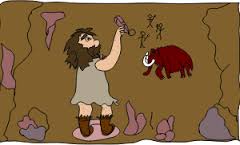 Now that my French 2 students have been introduced to both the passé composé and the imparfait, I wanted to introduce them to the idea of using these tenses to tell a story. Although I will not expect them to be able to correctly narrate past events consistently for some time, I did feel they were ready to be exposed to this challenging concept. Unfortunately, developing this unit was much more difficult than I had imagined! I had originally planned on using fairy tales to introduce the use of these tenses together. Although I realized that classic fairy tales are usually narrated using passé simple and imparfait, I naively thought that I would be able to find authentic simplified or modernized versions that were written in the passé composé. In spite several hours combing the Internet, as well consulting my virtual colleagues, I was not able to find what I was looking for. Even when I widened my search for other types of stories, most of the examples I found were narrated in either the passé simple or present tense. While I could have simply rewritten one of these stories using the two tenses, it was important to me that my students read an authentic text for input. As a result, I ended up choosing a blog entry by the imaginary character, Lulu, from Astrapi magazine to provide an authentic context in which the two tenses are used to narrate a story. I had used a couple of her entries in a school unit with these same students so they were familiar with the character. As described below, I used this text to provide an authentic model for the use of the two tenses, and then provided a series of teacher-created activities in which the students would use them to narrate/summarize a series of authentic texts.
Now that my French 2 students have been introduced to both the passé composé and the imparfait, I wanted to introduce them to the idea of using these tenses to tell a story. Although I will not expect them to be able to correctly narrate past events consistently for some time, I did feel they were ready to be exposed to this challenging concept. Unfortunately, developing this unit was much more difficult than I had imagined! I had originally planned on using fairy tales to introduce the use of these tenses together. Although I realized that classic fairy tales are usually narrated using passé simple and imparfait, I naively thought that I would be able to find authentic simplified or modernized versions that were written in the passé composé. In spite several hours combing the Internet, as well consulting my virtual colleagues, I was not able to find what I was looking for. Even when I widened my search for other types of stories, most of the examples I found were narrated in either the passé simple or present tense. While I could have simply rewritten one of these stories using the two tenses, it was important to me that my students read an authentic text for input. As a result, I ended up choosing a blog entry by the imaginary character, Lulu, from Astrapi magazine to provide an authentic context in which the two tenses are used to narrate a story. I had used a couple of her entries in a school unit with these same students so they were familiar with the character. As described below, I used this text to provide an authentic model for the use of the two tenses, and then provided a series of teacher-created activities in which the students would use them to narrate/summarize a series of authentic texts.
« J’ai encore un doudou! » (Lulu/Trotro packet )
I began the introductory part of this unit by give the students a copy of one Lulu’s blog posts, in which she describes an event from a recent class trip. Due to the nature of this lesson, I did not prepare an IPA-style interpretive task like I usually do. Instead, I gave the students pictures of a few vocabulary words that they would need to understand the gist of the story and a list of details to fill out in French. While I usually ask interpretive questions in English with students at this level, I wanted them to start to get a feel for the way the two tenses are used in this lesson. Preparing French statements allowed me to present additional examples of the tenses used in context and presented opportunities for the students to use the tenses in a controlled way in their written responses. To further call the students’ attention to how the imparfait and passé composé are used to narrate past events, I then gave the students a series of statements and asked them to choose whether each sentence referred to background information or an event that happened. While I had originally planned on this being a manipulative activity (I was going to make cards with the sentences and place them in two separate columns) time did not allow me to do so this time, so it was a pencil/paper activity. To my surprise, most of the students correctly identified the type of sentence, but seemed to do so without paying any attention to the tense of the verb. In fact, when I asked which of the two tenses were used for background information and which was used for events that happened, I got lots of blank stares even from the students had correctly completed the table. As a follow-up activity, I had the students number the events, in order to reinforce that idea that the passé composé is used for events that move the action of a story along. Following these input activities, I divided the students into pairs and gave each pair a set of pictures (lulu-doudou pics – printed on cardstock) which represented different aspects of the story. The students spoke in French to put the pictures in order and then I called on randomly-chosen pairs to orally summarize the story using their picture cards. The nature of the cards required that the students use both tenses and they did so quite well. For homework, the students wrote about this event from another character’s point of view. I felt this activity would allow them to rely heavily on the phrases they had seen, while still creating their own sentences. As a final step to this lesson, I asked the students to write their own blog entry for an experience similar to Lulu’s.
Trotro et le cerf-volant (same packet as Lulu)
While I wanted the students to have additional experience seeing the two past tenses in context, I did not have enough class time to devote to another written text. Instead, I decided to show the students a short video about one of their favorite cartoon characters, Trotro l’ane. I first gave them a handout with pictures representing some key vocabulary and then played the video, stopping occasionally to ask questions using the appropriate past tense. To provide further examples of the verbs used in context I gave the students a question/answer matching activity based on the video. Lastly, the students discussed a series of screenshots from the video in order to put them in chronological order by writing #1 under the first, #2 under the second and so on.
Rafara (rafara worksheets)
The main focus of this lesson on story-telling is the authentic book, Rafara. It is a text that is used by many French elementary teachers and I liked the idea of incorporating Francophone literature with these students, especially because this unit will be followed by a study of the film, Kirikou et la Sorciere. While the passé simple is used in the narration of Rafara, the activities I developed will allow the students to see the passé composé and imparfait in context. The original text will be quite difficult for these students, but I think the nature of the story makes it appropriate for practicing summary and narration. Although I purchased a copy of the hardcover book through amazon.com, I will give the students a packet with this pdf: http://laclassedecharlotte.eklablog.com/rafara-a58890841 (rafara ) The text is the same as the book, but the format is more practical as it has fewer pages. This teacher divided the book into 5 “textes” and I will use her same divisions. Each of the first four sections will form the basis of a one day’s lesson, and the fifth will be used on the assessment for the unit. For each lesson I have developed the following activities:
#1: An interpretive task in which the students identify key words, fill in supporting details, and guess the meanings of new words using context clues.
#2: A manipulative activity in which the students work with a partner to match questions and answers about the text. (I have included the questions/answers in the document, but I will make a larger font and print this page on cardstock for the manipulative activity.)
#3: A series of pictures that the students will use to practice retelling the section. (Coming soon!)
#4: A true/false formative assessment to be used at the end of the lesson.
(Note: Before beginning these lessons, I will show this video to provide some necessary background knowledge to the students: https://www.youtube.com/watch?v=KJQyNWhrHUQ )
As a summative assessment the students will complete an IPA with the following sections:
Interpretive Reading: An IPA-style interpretive task. (Rafara ipa )
Presentational Writing: The students will summarize the entire story using the pictures.
Interpersonal Speaking: Students will retell the story with a partner.
 The arrival of the new Ohio Scoring Guides for World Languages, as well as an excellent post by Amy Lenord served as an important reminder that I need to improve the feedback that I give my students. Although I have used a checklist for feedback in the past, I haven’t been completely consistent in using it as of late. Furthermore, my previous checklist was not aligned to these new scoring guidelines. It was definitely time to do some updating!
The arrival of the new Ohio Scoring Guides for World Languages, as well as an excellent post by Amy Lenord served as an important reminder that I need to improve the feedback that I give my students. Although I have used a checklist for feedback in the past, I haven’t been completely consistent in using it as of late. Furthermore, my previous checklist was not aligned to these new scoring guidelines. It was definitely time to do some updating!









